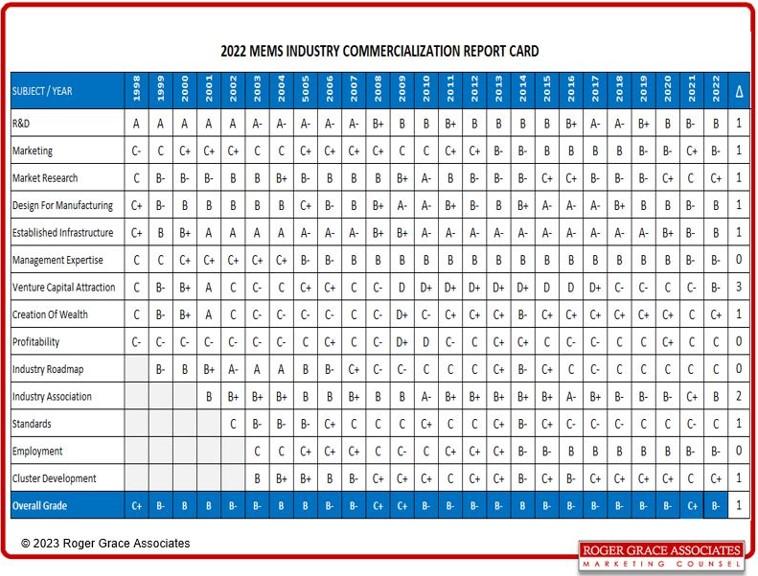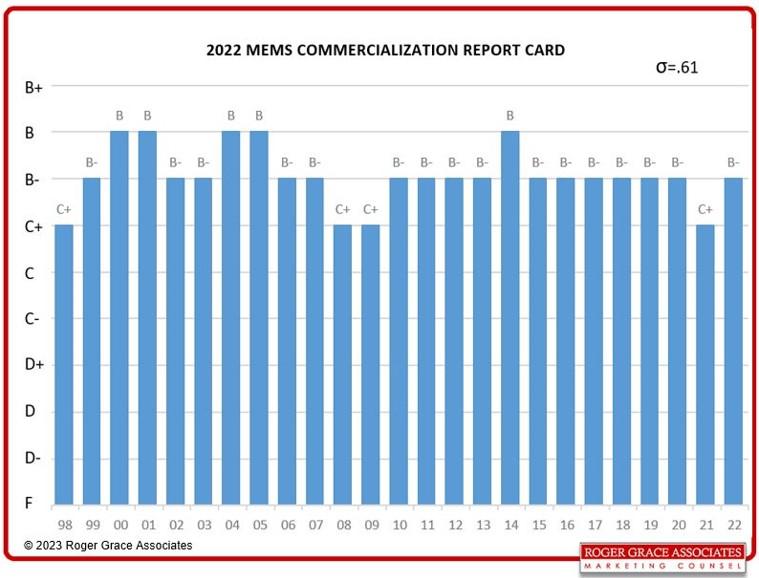Editor's Note: The following is a revision by the author of an earlier version posted July 19.
Results of the 24th annual MEMS Industry Commercialization Report Card Study have been tallied and, contrary to my earlier prognostications, the aggregated final grade increased to B-, up from C+ , reverting to the grade of the previous six years.
Additionally, the trend of the dramatic decrease in virtually all of the grades reported in the previous year’s results was greatly turned-around, resulting in at least one positive grade change in 10 of the 14 subjects (see Figure 1) . An earlier indication of this resulting positive change was suggested in my Sensors/MEMS Industry Forecast 2022 article.
The following paragraphs address the Report Card’s rationale, evolution, and research methodology since its inception in 1998. It continues to contribute to the widespread and successful commercialization of MEMS (Micro Electronic Mechanical Systems) worldwide.
Why a report card?
The initial and ongoing intent has been to report to the international MEMS community the barriers (or critical success factors) in the creation of a successful MEMS industry and to help guide its participants with insights to better succeed based on past performance. This is truly a “lessons learned” opportunity and in the words of the famous philosopher George Santayana, “Those who forget the past are condemned to relive it.”
In 1998, I felt it was long overdue to provide the MEMS community with a different and objective approach to reporting the progress of MEMS commercialization activities as a valuable alternative to the standard quantitative approach of sales volume and growth rate being reported on by several organizations. What was needed was a unique and simplified approach to create a vehicle that could intimately address the sentiments and attitudes of the MEMS community. Thus, the Report Card was born.
After considerable research into the topic of technology commercialization, I concluded that the 14 Report Card subjects (or critical success factors), were the best approach.
Methodology
For the most recent 2022 report card, 43 completed questionnaires were received from a select list of more than 120 international MEMS industry professionals in the Roger Grace Associates database. The emailed questionnaire required respondents to assign letter grades with plusses and minuses from A to D to each of the 14 subjects and provide verbatim comments on subjects they considered of unique importance. The typical respondent had an average of 25 years of MEMS industry experience. As such, the Report Card represents a total of over 1,000 person- years of cumulative MEMS experience. Over 75 verbatims were received.

Results
As stated above, the aggregated final Report Card grade for 2022 increased from C+ to B-
Here’s a summary of individual grades changes:
--One subject increased three grades (VC Attraction);
--One subject increased two grades (Industry Association);
--Eight subjects increased one grade;
-- Four were unchanged.
Several more noteworthy results:
Infrastructure… supply chain problems, which have been severe in the previous Report Card, appear to have been mitigated to a great degree and organizations are adopting novel approaches, including attempting to develop local suppliers for critical parts. This grade improved from B- to B.
Venture Capital Attraction…the increase in grade level by three was the most significant change of an individual grade in the history of the report card. Several organizations continue to receive major infusions in series funding. Grade improved from C- to B-.
Industry Association...MEMS and Sensors Industry Group (MSIG) has come up to speed and is providing the industry with valuable informational programs. Grade changed from C+ to B.
Conclusions
The aggregated final grade for the 2022 Report Card increased to B- from C+ with a standard deviation from 1998 to 2022 of 0.61. One subject increased three grades, one subject increased by two grades, eight subjects increased by one grade, four remained constant and there were no grade decreases. More than 75 verbatims were received from the participants of the study.
Contrary to my earlier personal prediction of an expected “more of the same” negative impact on grades as a result of Covid…the MEMS industry appeared to have demonstrated its true grit and resilience and overcame or mitigated many of the challenges that continued to be imposed with Covid during much of 2022.
While the positive change in only grade level of the aggregated final grade does not appear to be significant on its own, the true impact of the results can be assessed by reviewing the results of the individual grade differences from the previous year. Of the 14 subjects, 11 decreased by one grade, one decreased by two grades, one increased by one grade and one did not change. Additionally, the aggregated final grade increased by one grade level. This should be interpreted as very good news and a significant turnaround from the deleterious effects of Covid on the previous year’s grades.

I am hopeful that the results of this unique annual market study will continue to provide valuable guidance and actionable information to the MEMS community to support its commercialization efforts. It should be used as a valuable tool in their efforts to successfully overcome the existing barriers to commercialization in addition to continuing to act as critical input to help formulate strategies and tactics. As Covid continues, albeit it to a much lesser degree, residual effects continue to plague the industry. As such, I continue to encourage my consulting clients as well as all organizations to use this information discernably and judiciously to help them pivot in the market and to create and execute new strategies to become successful in the “new normal,” considering possible future health-driven and other economic uncertainties.

Due to the limited space allocated for this article, the availability of more information including significant and critical “verbatims” and recommendations to overcome the many existing commercialization barriers was not possible. However, an extensive Report Card Final Report is now available on the Roger Grace Associates website,which will offer a more detailed assessment of the findings, provide all verbatims and deliver recommended actions.Finally, the author wishes to thank all who participated in this research study for their kind, thoughtful, valuable and continued contribution to the betterment and success of the MEMS commercialization community.
Roger H. Grace is president of Roger Grace Associates, a Bonita Springs, Fla., marketing consultancy he founded in 1982 that provides market research, strategic marketing communications and business development services to the MEMS, sensors and capital equipment industry. His background includes over 40 years in high frequency analog circuit design engineering, application engineering, project management, product marketing and technology consulting. He was a founding member of MANCEF and currently is its vice president of the Americas. Specializing in micro electro mechanical systems (MEMS) and sensors for over 40 years, he is considered a pioneer in this field. He has authored over 40 technical feature articles, organized, chaired, and spoken at over 50 international technical sessions and is frequently quoted as an industry expert in major international technical and business publications. He is a recipient of the Outstanding Engineering Alumni of the Year in 2004 by Northeastern University and was bestowed the inaugural Sensor Industry Impact Award by Sensors Magazine in 2016. Mr. Grace held the position of visiting lecturer at the University of California at Berkeley from 1990 to 2003. His educational background includes a BSEE and MSEE (as a Raytheon Company fellow) from Northeastern University, and the MBA program at Haas Graduate School of Business at UC Berkeley.